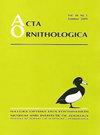波兰西南部白鹳Ciconia Ciconia种群的强烈下降:海拔和土地利用变化的不同重要性
IF 1.3
4区 生物学
Q3 ORNITHOLOGY
引用次数: 4
摘要
摘要研究鸟类种群的长期趋势需要大量的数据,而大多数鸟类都无法获得这些数据。白鹳鸟是独一无二的,被监测了一个多世纪,很好地反映了现代环境的变化。根据国际白鹳普查(IWSC),白鹳在全球和国内的数量每10年估算一次。我们展示了2014年IWSC的尚未公布的数据,这些数据来自波兰的主要物种据点。我们对全国23%的地区(包括山区)的人口规模进行了评估,并将其变化与之前的IWSC 2004进行了比较。我们在土地利用转变中寻找潜在的趋势驱动因素,检查了沿海拔梯度的人口变化,并比较了全球、国家和区域人口的长期趋势。2014年,波兰西南部繁殖了2560对(3.61对/100平方公里),与2004年相比下降了35.5%。下降与海拔高度呈强烈的负相关,即低地的下降是山区的两倍。草地、农田、森林和建成区面积的变化都是下降的弱预测因子。波兰西南部鹳的减少与2004-2014年全国范围内的稳定趋势相矛盾(尽管最新的全国数据也表明下降),这与全球人口的增长不一致。趋势的异质性表明,波兰目前可被视为一个过渡地区,位于鹳数量不断增加的大型繁殖区之间。值得注意的是,西部地区的增减边界与两个迁徙种群的划分一致,这表明趋势的异质性可能与迁徙路径和越冬地有关。总体而言,我们的数据证实了该物种最近的范围转移,并且显示出基于区域数据得出鹳人口统计学的一般结论的困难。本文章由计算机程序翻译,如有差异,请以英文原文为准。
Strong Declines of the White Stork Ciconia ciconia Population in South-Western Poland: A Differentiated Importance of Altitude and Land Use Changes
Abstract. Studies of long-term trends in avian populations require large-scale data not available for most bird species. The White Stork Ciconia ciconia is unique being monitored for over a century and well-reflecting modern environmental changes. Its worldwide and national populations are estimated every 10 years thanks to the International White Stork Censuses (IWSC). We present the yet unpublished data of the last IWSC 2014 from the main species stronghold, Poland. We assessed the population size and compared its changes with the previous IWSC 2004 in 23% of the country area, including mountains. We looked for potential drivers of trends among land use transformations, checked population changes along altitudinal gradient, and compared the long-term trends in the global, national and regional populations. In 2014, 2560 pairs (3.61 pairs/100 km2) bred in south-western Poland, a decline by 35.5% compared to 2004. Decreases were strongly inversely related to the altitude, i.e. declines in lowlands were twice as high as in the mountains. Changes in area of grasslands, croplands, forests, and built-up areas were all weak predictors of the decline. Stork decrease in south-western Poland contradicts a stable country-wide trend in 2004–2014 (although the latest countrywide data also suggest a decline), which is inconsistent with the increase of the global population. Heterogeneity in trends indicates that Poland could be currently viewed as a transitional area, lying between large breeding areas inhabited by increasing stork populations. Notably, the western border between areas of increases and decreases coincides with the division into two migratory populations suggesting that the heterogeneity of trends may be related to migration paths and wintering grounds. Overall, our data confirm recent range shift of the species, and show difficulties in drawing general conclusions on stork demography based on regional data.
求助全文
通过发布文献求助,成功后即可免费获取论文全文。
去求助
来源期刊

Acta Ornithologica
生物-鸟类学
CiteScore
2.10
自引率
0.00%
发文量
14
审稿时长
>12 weeks
期刊介绍:
Publishes scientific papers (original research reports, reviews, short notes, etc.) and announcements from all fields of ornithology. All manuscripts are peer-reviewed.
Established in 1933 as Acta Ornithologica Musei Zoologici Polonici, since 1953 continued under the present title.
Published twice a year by the Natura Optima Dux Foundation under the auspices of the Museum and Institute of Zoology, Polish Academy of Sciences.
 求助内容:
求助内容: 应助结果提醒方式:
应助结果提醒方式:


